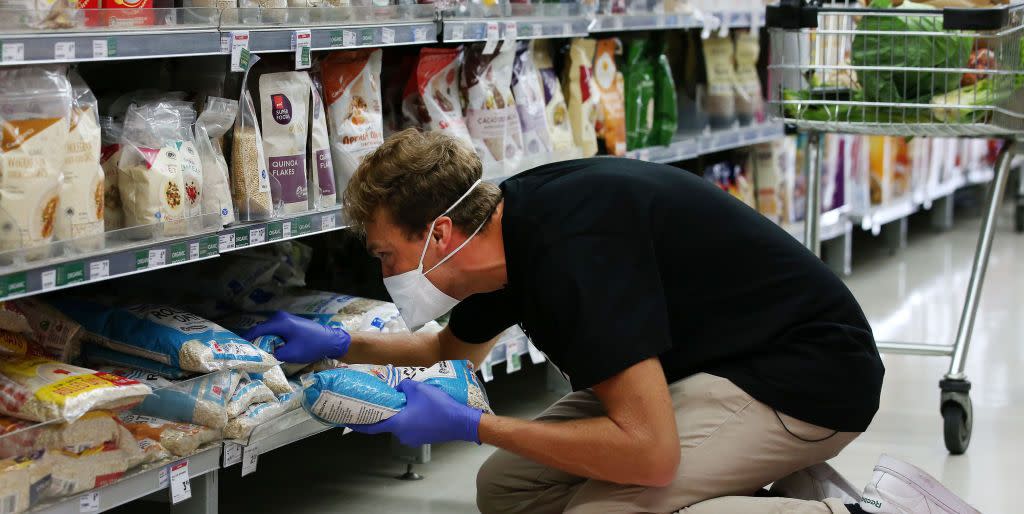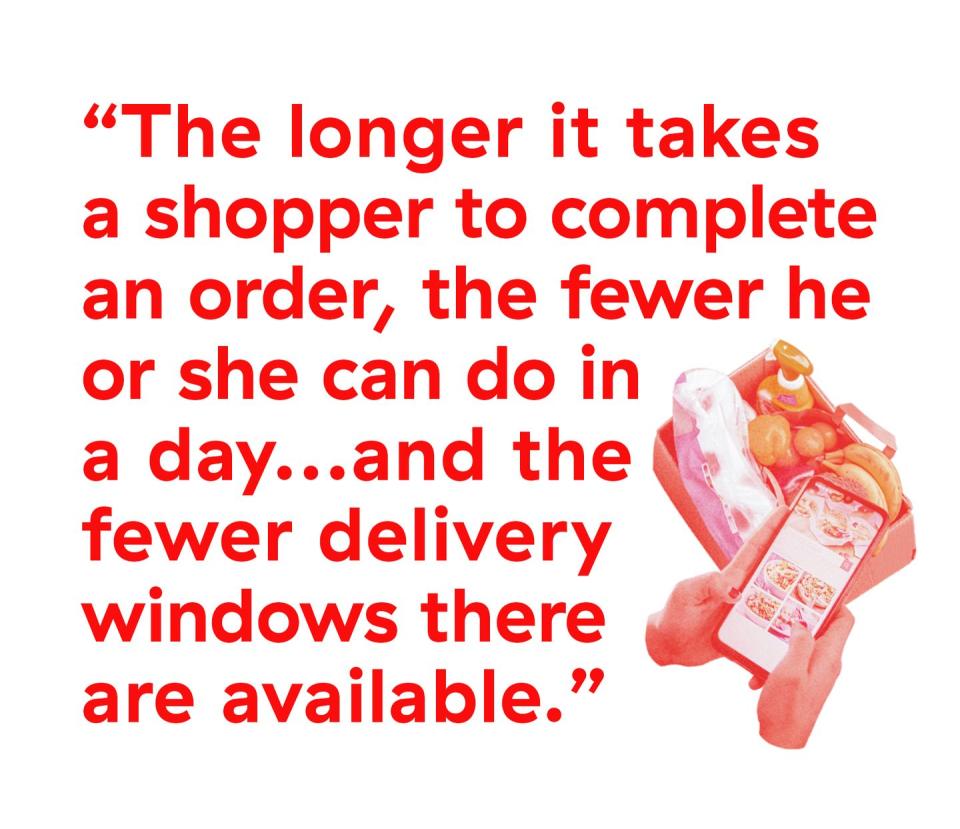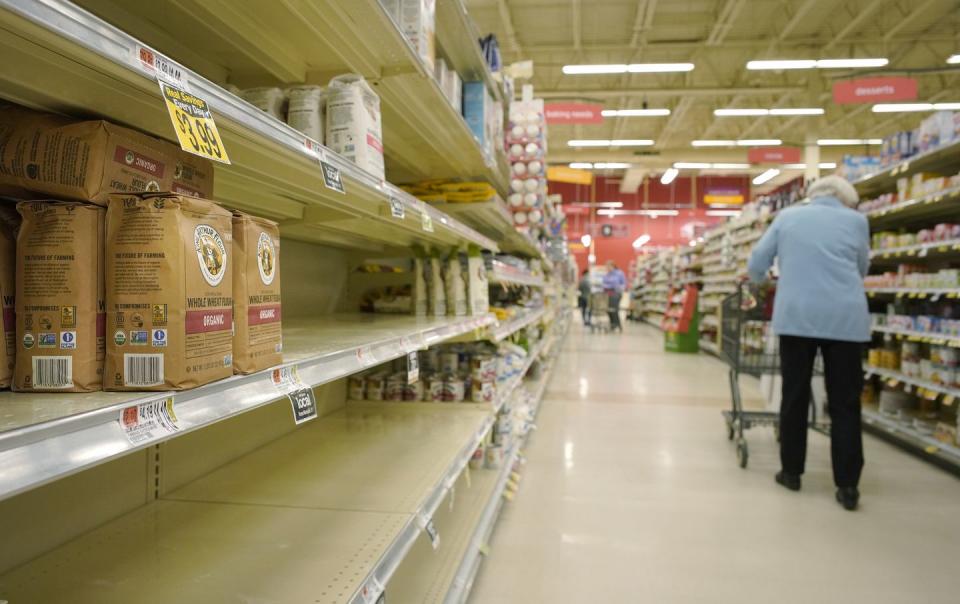All Of Your Stress Shopping Is Messing With The Grocery Supply Chain, Experts Say

You work through every menu, window, and item, hunting for those brands you love, weighing the must-haves with the sure-would-likes. And sure, you're willing to spend a bit more—food is a rare comfort right now. But then you have to find a delivery time, and those can be in short supply. Same with a few of your items, too. It turns out, they're out of stock, and your favorite snack, well it's there, just not in your favorite flavor.
While a lifeline for many, the explosion of online grocery delivery during COVID-19 has come with a few issues. Many services have been available for years, but demand for online grocery order and delivery has boomed in the last few weeks. Instacart weekly app downloads have increased seven-fold—meaning seven times as many people are vying for the same (albeit slowly growing) number of open delivery slots.
Across the industry, the unexpected and unprecedented surge in demand has left companies scrambling to shorten wait times. For most companies, that means hiring more shoppers, distribution center workers, and delivery people. Instacart explained that delivery windows are dependent on store volume and the availability of shoppers. Services like theirs rely on a network of shoppers—and Amazon on drivers—and if there aren't enough, customers will see fewer delivery times. In response, Instacart is hiring 300,000 more shoppers over a three month period. Amazon has hired 100,000 more workers for its grocery service, and is in the process of adding another 75,000.

Even when there are enough shoppers though, an inability to get into grocery stores or navigate crowded markets efficiently slows many orders. The longer it takes a shopper to complete an order, the fewer he or she can do in a day...and the fewer delivery windows there are available. To combat this, Amazon is changing store hours in many Whole Foods to allow delivery-only hours; one location in Woodland Hills, CA, is even closing to consumers to become a delivery-only location. While Instacart does not have the benefit of brick-and-mortar stores like Amazon, it has partnered with many retailers to implement "pre-opening and post-closing hours access for Instacart shoppers" to speed shopping times and increase delivery availability.
So let's say for the sake of argument you score a delivery, there's a great possibility it'll be short some staple products, like flour, meat, or milk. But know this: High demand doesn't mean there's a legitimate shortage. For most of these products, it's just a lapse between how fast customers can buy, versus how quickly suppliers can restock shelves. "At any time there are one to two weeks of non-perishable food and three days of perishable food in the supply chain," says Greg Shewmaker a supply chain expert and Co-Founder of the food data company TeakOrigin. As such, the supply chain takes a bit of time to move food to stores after surges in buying.
"Shortages are not necessarily from a manufacturer or processor, but a consumer demand issue—people going out and buying more," adds Martin Bucknavage, a food industry specialist at Penn State Extension. "We expect at some point people's home shelves will fill up and the goods will start to be back on shelves at grocery stores." Even so, this effort may not happen at the same time for you and, say, your sibling across the country. "What I'm hearing is that the build up is happening, but it may not be evenly distributed," says Shewmaker, "but I don't think it's a long term problem."
You may also have experienced shortages on less important items, too— like every single flavor of Pringle, a bar of chocolate, or even tropical fruit. These can be explained by a number of factors, including that same increased consumer demand, as well as grocer and distributor stocking choices.

Many grocers and online services rely on past data to inform how much of any product they carry, and quarantine has created an unexpected shift and shortage in some of our favorites. "The amount of inventory online distribution centers have is based on history. You wouldn't normally buy three cans of Pringles, you'd buy one," says Shewmaker. "But we are all impulsive, and right now everyone is eating a bit more carbs than we usually do. Demand is going up and it doesn't match history; the supply chain isn't prepared for that." So, it may take a few weeks for grocers and online sellers to get their supplies of stress-buy snacks and candies in line with what guilty pleasures our quarantined bodies demand.
Additionally, some grocers and delivery services are cutting down the number of flavors, varieties, or products in order to more efficiently deliver staples to their customers. "A lot of grocery stores have restricted focus to main items they need," says Bucknavage. "Instead of a grocery store carrying mangoes, they'll say we are going to bring in a lot more potatoes." And while they may carry some snacks, some stores will cut down on the variety. "A lot of stores aren't carrying the whole line of options; it has reduced some of the variability you can buy," says Bucknavage.
Many stores and delivery services are also prioritizing essentials, which may add delays to those less needed products. Target's website says, "The things our guests need most—cleaning supplies, food, over-the-counter medicine and baby products—are fast-tracked through the supply chain and prioritized for re-stocking." While Amazon's says, "We're focusing on high-priority items to ensure the fastest delivery of household staples, medical supplies, and other high-demand products coming into our fulfillment centers." At the time of publishing, Walmart, Kroger, and Peapod had not responded to Delish for comment.
Of course, if the pandemic continues or worsens, issues could develop in the supply chain and for more than just online delivery services. Travel restrictions or immigration changes could limit the workforce available to pick and process much of our nation's produce. "We've always counted on a worker program for folks to come in and harvest crops, but how many workers will be able to when it's time? We're really not close enough to know," says Bucknavage. Similar concerns affect high-touch industries like meat processing where slowing the spread of the virus could mean decreased production. "Smithfield, Cargill, and Tyson have already shut down big plants. They've had infections in the plants, that's going to impact one end of the supply chain," says Shewmaker.
In order to give yourself the best chance of getting your grocery delivery, check for delivery windows frequently, as many change due to the number of shoppers. Be sure to also give flexible delivery times, and input second choices into apps that allow you to if your first-choice product is missing. Additionally, many experts recommend looking for local farmers markets, farms, and specialty stores, as many are responding to the quarantine by creating their own delivery, direct-to-consumer, or contactless pick-up services. Not only would you be getting the products you want, you'd be supporting a small farm or business.
Art by Alyssa Gray
You Might Also Like

